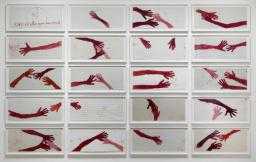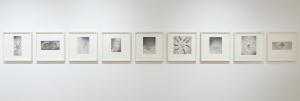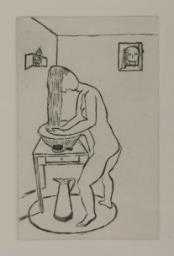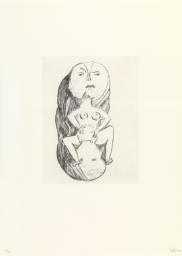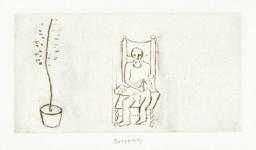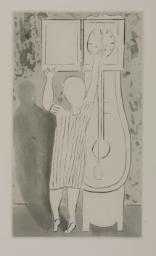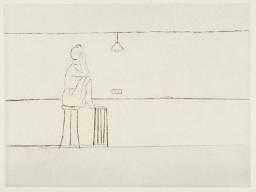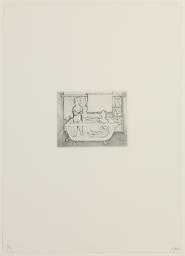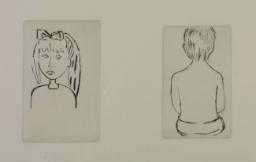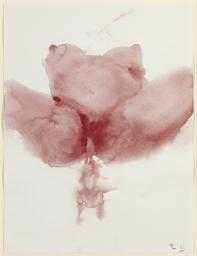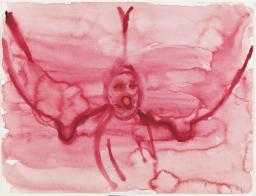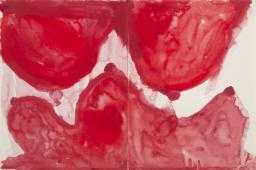
Not on display
- Artist
- Louise Bourgeois 1911–2010
- Medium
- Gouache on sandpaper
- Dimensions
- Frame: 352 × 280 × 35 mm
- Collection
- ARTIST ROOMS
Tate and National Galleries of Scotland. Lent by Artist Rooms Foundation 2013
On long term loan - Reference
- AL00340
Summary
Home for Runaway Girls is comprised of black and white gouache paint on sandpaper, mounted in a frame. The oval-shaped sheet of sandpaper is painted black, with an inscription in capital letters painted on it and smudges of white paint. The inscription reads ‘HOME FOR RUN AWAY GIRLS: EMPTY HOUSES LES FILLE MÈRE D’ANTONY’. Most of the text runs down the centre of the sandpaper except the reference to the ‘Fille Mère d’Antony’ which curves up the right side of the elliptical shape. The black sandpaper sits on a white surface within the frame, giving the overall appearance of a rudimentary plaque.
This work references a home for young, unwed mothers in the town of Antony in Northern France where Bourgeois lived as a child. In French, ‘Fille Mère’ was the term for an unmarried mother who, in early twentieth-century Catholic France, could be cast out of her family home. The ‘EMPTY HOUSES’ offered to the ‘RUNAWAY GIRLS’ in Bourgeois’s work then, not only mimics an advertisement for available rooms, but also alludes to the future awaiting them. The girls are offered houses not homes – suggesting that they are devoid of both the comforts and constraints of domesticity and family. The rough surface of the sandpaper, marked by the gouache, is also suggestive of discomfort and unhappiness, as well as a degree of toughness and resilience.
Runaway Girls could also be seen as a self-portrait of sorts, as Bourgeois once remarked: ‘I was in effect a runaway girl. I was a runaway girl who turned out alright.’ (Quoted in Gorovoy and Tilkin 1999, p.15.) In this statement, the artist refers to her decision to leave Paris for New York in 1938 after marrying the American art historian Robert Goldwater. Although Bourgeois was married when she ran away, her continuing identification with girlhood highlights her own resistance to domestic life. The character of the runaway girl appears in some of her early New York paintings, including Runaway Girl c.1938 (Cheim & Read, New York), which called particular attention to Bourgeois’s choice to leave her family and France behind. The freedom-seeking aspect of the runaway girl is evident in this passage from Bourgeois’s writing:
The Runaway Girl who never grew up…
I do not need a safety net,
Breakfast, big lunch or afternoon snack
I do not need any visitors, telephone
Calls or small mash notes…
I don’t need anything, I don’t confuse anything.
I can wait, I am not afraid. I am grown up.
Nothing is missing.
(Askew and d’Offay 2013, p.42.)
Despite Bourgeois’s declaration of being ‘grown up’, the artist returned to themes and memories from her childhood throughout her artistic career. The home, motherhood and abandonment are also recurring motifs registering Bourgeois’s feelings of displacement, as both a French woman in America and a woman artist in an art world dominated by men. The poignant, bilingual inscription in Home for Runaway Girls is characteristic of her negotiation of place, belonging and memory.
Further reading
Jerry Gorovoy and Danielle Tilkin, ‘There Is No Place Like Home’, in Louise Bourgeois: Memory and Architecture, exhibition catalogue, Museo National Centro de Arte Reina Sofía, Madrid 1999.
Francis Morris (ed.), Louise Bourgeois, exhibition catalogue, Tate Modern, London 2007, reproduced p.249.
Lucy Askew and Anthony d’Offay, Louise Bourgeois: A Woman Without Secrets, exhibition catalogue, National Galleries of Scotland, Edinburgh 2013, p.42, reproduced p.43.
Allan Madden
The University of Edinburgh
November 2014
The University of Edinburgh is a research partner of ARTIST ROOMS.
Does this text contain inaccurate information or language that you feel we should improve or change? We would like to hear from you.
You might like
-
Louise Bourgeois 10 am is When You Come to Me
2006 -
Louise Bourgeois Femme
2007 -
Louise Bourgeois À L’Infini
2008–9 -
Louise Bourgeois Ode à Ma Mère
1995 -
Louise Bourgeois Toilette
1994 -
Louise Bourgeois Birth
1994 -
Louise Bourgeois Paternity
1994 -
Louise Bourgeois Woman and Clock
1994 -
Louise Bourgeois Empty Nest
1994 -
Louise Bourgeois Children in Tub
1994 -
Louise Bourgeois Boy and Girl
1994 -
Louise Bourgeois The Birth
2007 -
Louise Bourgeois The Feeding
2007 -
Louise Bourgeois The Family
2008 -
Louise Bourgeois The Friendly Landscape
2008

